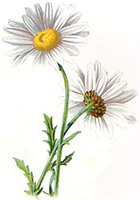






So there you have it. Nine reasons why I wouldn't be without my scissors. I know, I know - the title said ten. But I've run out. Have I forgotten anything? Can anyone else suggest the tenth?
This post was part of a group writing project suggested by Darren Rowse of Problogger - a site well worth visiting for ideas on blogging.


We were at

The crop growing in the field above is soya, one of the main agricultural products of the area. I went riding in the country one day and saw that they were experimenting with sowing soya and winter wheat at the same time. The winter wheat grows and is harvested before the soya really starts coming through, but once the wheat is gone it takes over. The advantage is that the field is only ploughed once, instead of twice, meaning less work but also less soil erosion and less air pollution from the tractors. The fields grown like that didn't seem to give nearly as great a yield as the one above, however, so I wonder if the experiment might be dropped. Does anyone know of anywhere else it's been tried?

I spent a lot of time walking and biking in the pine woods. I can't claim they were deserted, as they were constantly crossed by people going or coming back from the beach. But I managed to find some quiet shady paths.

The pines were Umbrella Pines (



For information on the danger posed to the red squirrel population by the greys : The European Squirrel Initiative





There's a lot of contradictory information about the plant on the web. You'll read it thrives in the heat and the sun. Or that it should be protected from too much direct sunlight. That it can't take temperatures under 7°C. And that it will survive frosts. That it does well in poor soil. That it likes a rich compost. The list goes on.
In my experience it's a tough little plant that will grow under a range of conditions. I don't think there's any doubt that it likes the sun (it's native to South Africa after all). But I find that its also fairly hardy. I cover mine in winter but most of my neighbours don't and it seems to survive, despite the fact that temperatures may be well below zero at times.
I don't give mine any special treatment and, apart from the lack of blooms this year, have never had problems. It's grown in ordinary soil, and fed and watered much the same as any other plant. As the water here is very hard, plants which are really particular about acidic soil just don't make it under normal watering conditions, but I've never had problems on that front.
Another reason I may not be getting many blooms this year is because I didn't prune this spring. Plumbago blooms off the new wood, and can be cut back fairly enthusiastically to encourage new growth and keep it in check. In a garden it can reach three or four feet high, so in a container it needs a bit of restraint.

It's also one of the few plants I have which doesn't seem to suffer from red spider mite - or anything else for that matter. It's poisonous, and for those of you who have the problem, deer will avoid it. (That does come from the net - we don't get many on the balcony.) It does attract butterflies, though as I've never had caterpillar damage i presume it's just for the flowers.

For me, the powder blue colour of my plant is the "classic" plumbago colour, though I've seen some darker blue varieties which were also very striking. Personally, I'm less keen on white.
One last thing - if you're growing it for the first time, don't panic if nothing seems to be happening in spring. It's deciduous and the new leaves come through very late. When everything else is bursting into life it's still there, brown and dead looking. But it isn't. Stick with it.



I am a
Daisy

What Flower
Are You?